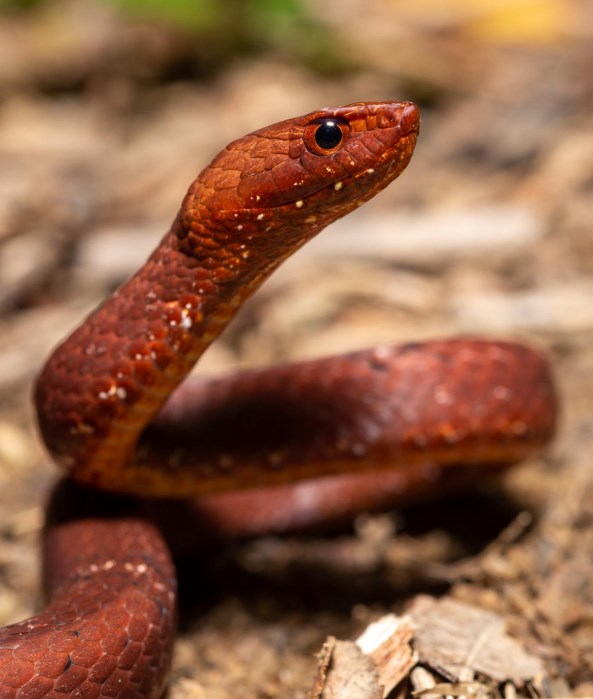By Chermaine Lee and Lawrence Hylton
A veil of light fog enveloped a particularly dark night as the group of four arrived by taxi at a remote mountainside, with few street lights in sight. But they insisted that the driver drop them off.
The group then switched on their torches for their planned activity of the evening, and for many other evenings to come. With cameras in hand, they shone their beams on every tree, every trunk, every drain and every bush.

The “herpers” were embarking on a night hike in search of reptiles and amphibians – snakes, geckos, lizards, turtles and so on – eager to identify new and rare species, some of which are nocturnal. The word “herping” has the same Greek root as herpetology which means “creeping”.
Lawrence Hylton, a 27-year-old avid herper, told HKFP that he estimates there are more than 200 herpers in Hong Kong.
Hylton, who has been out for five nights a week since May, was one of the herpers to start exploring nature after being stranded in the city due to the strict border controls induced by the Covid-19 pandemic.

In addition, weeks of strict social distancing measures saw restaurants shut and public gatherings limited to a maximum of four people. As the bright lights of the city’s nightlife faded, some people became herpers.
And why not? Experts say Hong Kong has the ideal climate for herping. “Hong Kong is on the edge of tropical-subtropical climates, which increases the diversity [of reptiles and amphibians] here,” said Jonathan Fong, assistant professor of the Science Unit at Lingnan University, whose research focuses on herpetology.
About 40 percent of Hong Kong is made up of country parks and other green areas, he stressed. “You can herp easily near your home.”

Reptiles and amphibians are more common than urbanites might think, Hylton added. The first time he saw a snake was when he was five years old – a king cobra in his neighbour’s toilet. Trembling, he screamed for help. But the experience did not stop Hylton from searching for snakes and other reptiles in later life.
“I enjoy the danger of encountering snakes – the adrenaline rising. It makes me feel more grateful to be alive,” he said.

Leading the night hikes, Hylton took me and a group of herpers on a route through streams, bushes and waterways that yielded glimpses of rare snakes, vulnerable geckos, large caterpillars and, unexpectedly, endangered plant species.
One of the “treasure hunts” culminated in the discovery of one of Asia’s most venomous snakes – the many-banded krait – which is nocturnal and whose venom is deadly. The black-and-white striped reptile was slithering about on a concrete slab before one of the herpers covered it with a pillowcase to try to calm it down.

“They are just scared but they don’t usually bite people. That’s a big misunderstanding among many people,” one herper explained.
Herpers eagerly took out their cameras and competed to catch images of the snake before uploading them to social media. The hashtag “#herping” has over 300,000 posts around the globe, signalling the popularity of this activity.
After taking their photos, the herpers gently guided the snake back to the bushes and watched it making its way back to the forest like a group of anxious parents.
“Would you want to touch it?” one of the herpers asked me, when we encountered a non-venomous mountain water snake.

Growing up in a densely populated city, my knee-jerk reaction was to take a few steps back and try not to scream when they handed me the small snake with yellow-white vertical banding.
At first, I was worried about accidentally dropping it or being bitten. But after I began to relax, I enjoyed watching how it moved around my fingers, and found it quite adorable. That was an important moment in my wilderness education.
“Going out to observe [nature] is a good way to become more aware of the diversity around us,” said Fong. “We have to respect them, and not damage their homes, and be careful of some potentially dangerous species. It can help people appreciate and respect nature.”

Hylton said he and some other herpers love to showcase their photos on social media, but refuse to disclose where they were taken for fear that poachers will target vulnerable and endangered species.
“The high point for me was spotting a pangolin in Hong Kong but I couldn’t tell anyone where,” Hylton said. Pangolins are the most trafficked mammal in the world, and in high demand by Chinese consumers for use in traditional medicine.
Between 2014 and 2018, seizures of pangolins skyrocketed tenfold, according to a UN report. In fact, Hong Kong’s central geographical location, free trade policy and logistical efficiency made it one of the world’s hubs for the illegal wildlife trade.

Millions of live animals, plants and their derivatives are both legally and illegally transported into Hong Kong, according to a 2018 report by a group of animal organisations.
“In large part, these trades supply the Traditional Chinese Medicine (TCM) sector, followed by the fashion, pet or aquaria and seafood markets. Much of the trade relies on threatened species as evidenced by at least two-thirds of the species seized in Hong Kong,” the report said.
Over the last decade, the range of endangered species imported into the city jumped by over 50 per cent, it added.

Reptiles and amphibians are at the forefront of extinction threats. Over 40 per cent of the 26,500 endangered species are amphibians, according to the “red list” drawn up by the International Union for Conservation of Nature.

In Hong Kong, reptiles and amphibians are being seized in large quantities, including 20,000 turtles and tortoises over a five-year-period, the 2018 report adds – and that’s only the number of cases which come to light.
“There are people that hunt endangered animals for the pet trade,” said Fong. “The value can be very high, so there is always a danger. When you meet a herper, information [about animals and locations] is often not revealed, because they are not sure if you are looking for animals with a malicious purpose.”
As long as people minimize disturbance to the animals and the environment, Dr Fong sees no harm in herping. For beginners, his advice is to be prepared, including a headlamp and a mobile phone for emergencies.

Hylton said identifying which snakes are venomous is an important first step, so that herpers don’t end up becoming severely injured. But he stressed that the activity is for everyone, young and old.
“There are no prerequisites for herping. Anyone can join,” he said.
Support HKFP | Policies & Ethics | Error/typo? | Contact Us | Newsletter | Transparency & Annual Report | Apps
Help safeguard press freedom & keep HKFP free for all readers by supporting our team

Original reporting on HKFP is backed by our monthly contributors.
Almost 1,000 monthly donors make HKFP possible. Each contributes an average of HK$200/month to support our award-winning original reporting, keeping the city’s only independent English-language outlet free-to-access for all. Three reasons to join us:
- 🔎 Transparent & efficient: As a non-profit, we are externally audited each year, publishing our income/outgoings annually, as the city’s most transparent news outlet.
- 🔒 Accurate & accountable: Our reporting is governed by a comprehensive Ethics Code. We are 100% independent, and not answerable to any tycoon, mainland owners or shareholders. Check out our latest Annual Report, and help support press freedom.
- 💰 It’s fast, secure & easy: We accept most payment methods – cancel anytime, and receive a free tote bag and pen if you contribute HK$150/month or more.
MORE Original Reporting
HKFP has an impartial stance, transparent funding, and balanced coverage guided by an Ethics Code and Corrections Policy.
Support press freedom & help us surpass 1,000 monthly Patrons: 100% independent, governed by an ethics code & not-for-profit.









